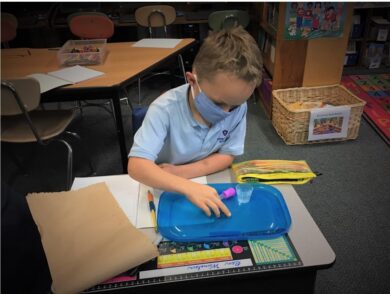 Third-grade students engaged in an activity using water drops and pennies to experience the various steps of scientific inquiry. First, the girls and boys attempted to see how many drops of water could be dropped on a penny before spilling off. They recorded their results and discussed why the numbers were so varied. Using their recorded data, the class made a list of the variables that could have affected the results. Then, each student scientist came up with a testable question and determined which variable they would test (their experimental factor) and, therefore, which things would have to stay the same (control factors). For example: Does the heads side or tails side of the penny hold more water? Does the age of the penny matter? Students hypothesized or predicted what they thought would happen. They conducted their experiments by carefully dropping water on pennies and recording the results of each trial. They then took their data and created a computer generated bar graph representing their results. Next, they analyzed their graphs and completed a “lab report” reflecting on their hypotheses. This led to new questions being posed. This is the cyclical nature of science in action.
Third-grade students engaged in an activity using water drops and pennies to experience the various steps of scientific inquiry. First, the girls and boys attempted to see how many drops of water could be dropped on a penny before spilling off. They recorded their results and discussed why the numbers were so varied. Using their recorded data, the class made a list of the variables that could have affected the results. Then, each student scientist came up with a testable question and determined which variable they would test (their experimental factor) and, therefore, which things would have to stay the same (control factors). For example: Does the heads side or tails side of the penny hold more water? Does the age of the penny matter? Students hypothesized or predicted what they thought would happen. They conducted their experiments by carefully dropping water on pennies and recording the results of each trial. They then took their data and created a computer generated bar graph representing their results. Next, they analyzed their graphs and completed a “lab report” reflecting on their hypotheses. This led to new questions being posed. This is the cyclical nature of science in action.
Mr. Jennifer Coulter
Grade 3 Teacher
